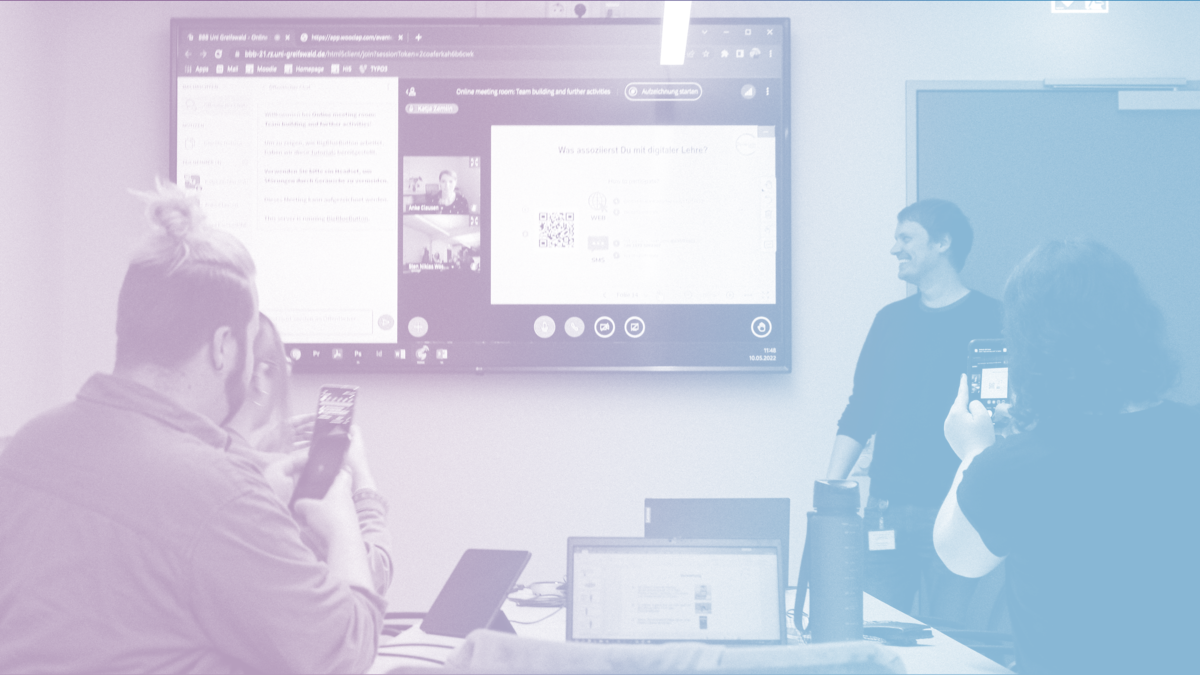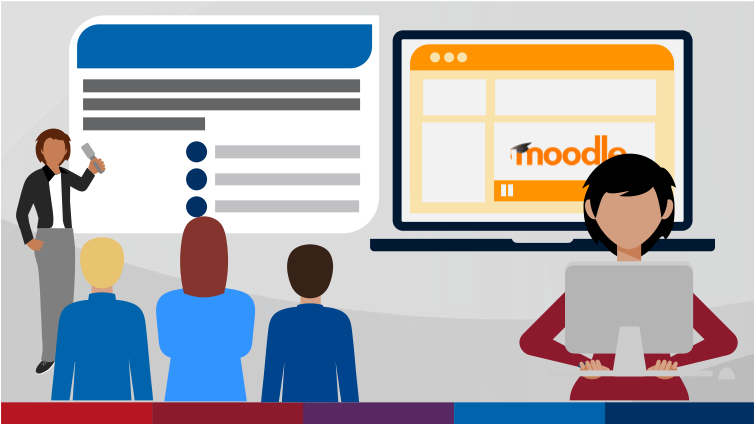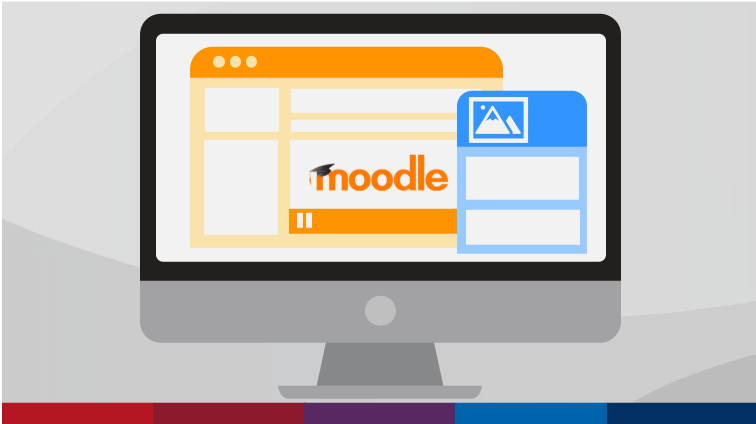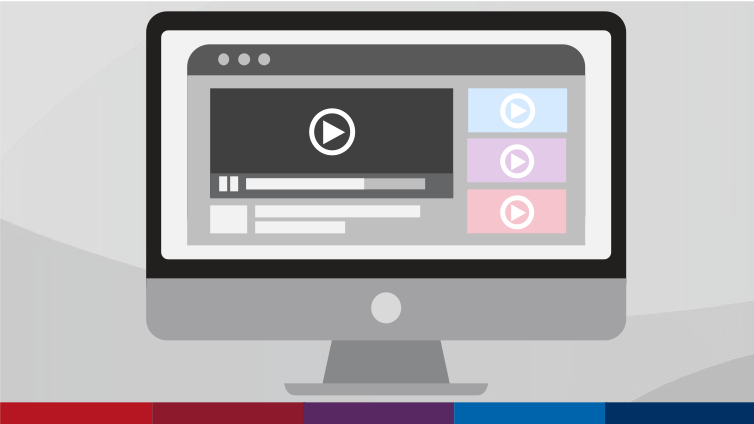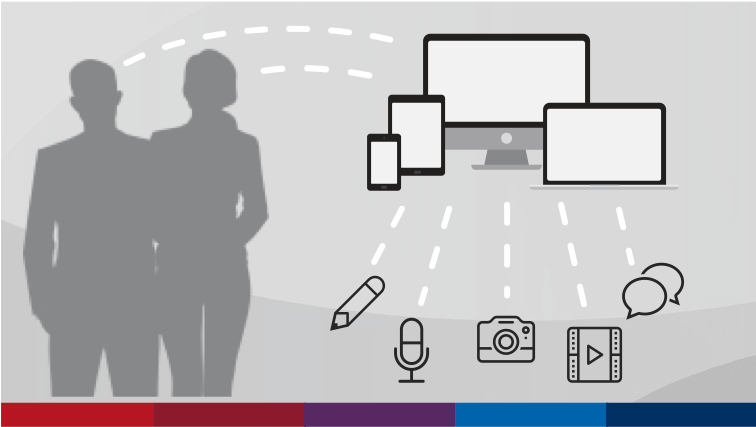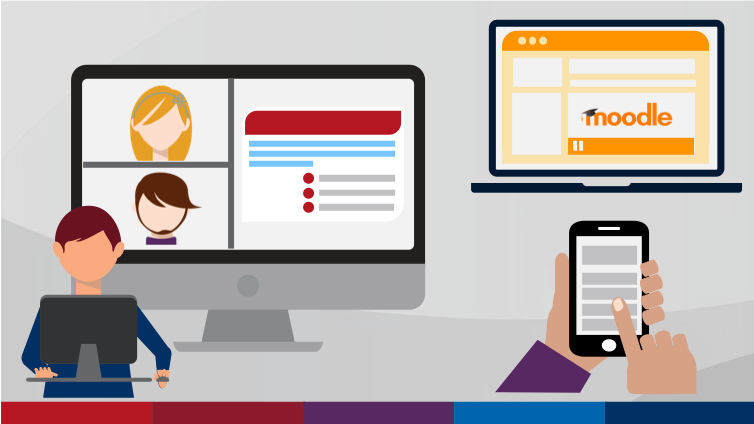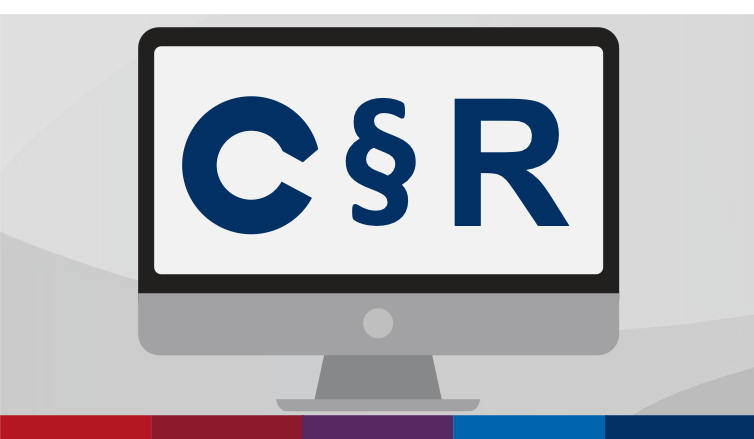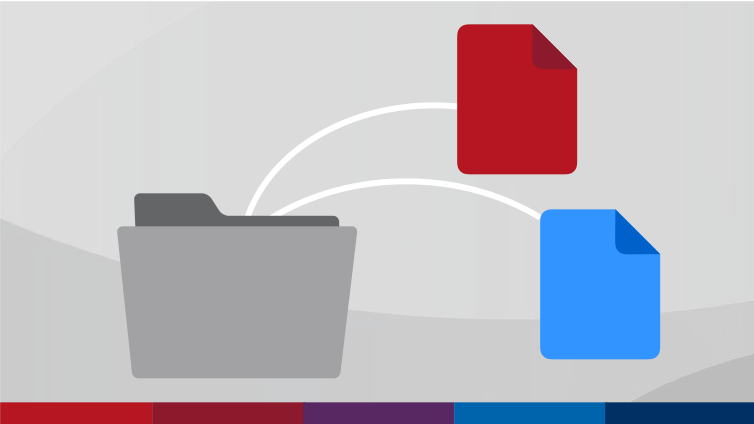Didactics: Teaching Concepts using Digital Tools
Preliminary Considerations and Planning Steps for Digital Teaching Concepts
The planning of media-based university teaching is increasingly subject to the use of flexible forms of teaching and learning with digital tools. These teaching plans capitalise on the implicitness with which media is used for teaching and learning purposes, helping to extend the teaching possibilities.
That is why the digitisation of teaching concepts and contents at the University of Greifswald should always be considered according to the positive influence they will have on teaching and learning and why it has been included in the Digital Education Strategy.
Below, you will find a summary of important considerations regarding teaching methods and planning steps for digitised teaching concepts.
Step 1: Classify your Own Course
Would you like to change your course to a digital format? The following guiding questions will help you structure the process and organise important core ideas in advance. Furthermore, you can make use of our 1:1 individual advise on various possibilities with regard to teaching methods or technology.
Didactic Framework Model
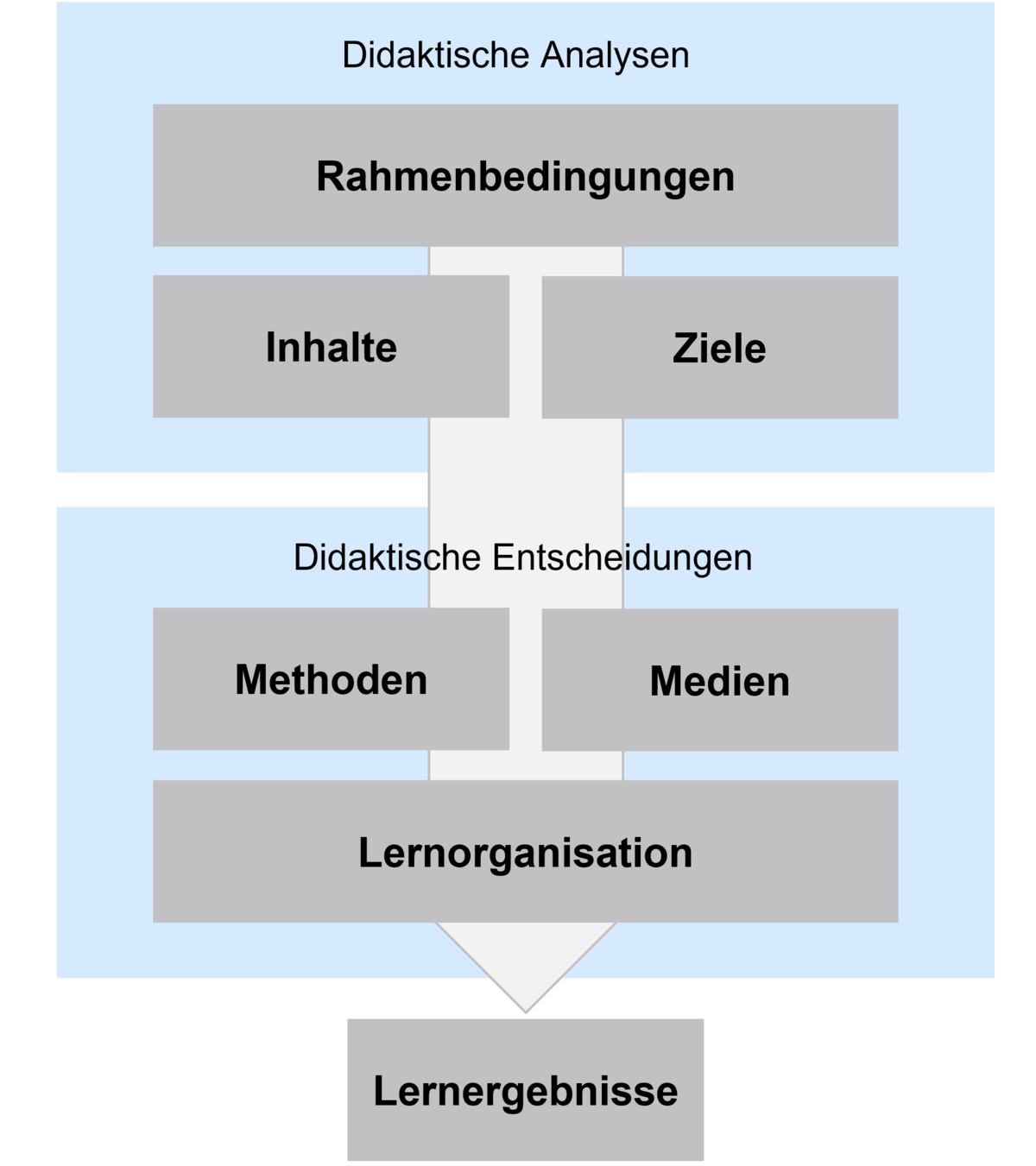
Systemic Reflection of the Teaching Concept
The didactic framework model can provide practical assistance when designing a class that is to be taught in digital format. In the model, the planning of courses is outlined systemically, with essential factors for one's own teaching concept. Key questions can be assigned to these factors easily.
Analysis of Teaching Methods
General conditions: Which target group, which technology, which learning situation can I expect?
Teaching contents: What should students learn?
Teaching goals: What should the students be able to achieve by the end?
Decisions Regarding Teaching Methods
Methods: Should learning be expository, explorative, problem-oriented, playful or cooperative, and should it include case studies?
Media & Metamedia: Are texts, images, audio, books, videos, apps and/or digital applications suitable?
Organisation of learning: How do I want to organise learning in terms of time and space, structure of content, distribution of tasks, guidelines for learners, monitoring, administrative and organisational tasks, group formation?
Teaching comprises instruction, supervision, activation and assessment
What do you want to achieve with your teaching?
| Teaching activity | Specific purpose | Suitable digital tools (examples) |
|---|---|---|
| Instruct | Using and designing teaching materials to share information | Learning modules in Moodle, texts, films (e.g. screencast videos), audio podcasts |
| Supervise and communicate | Designing measures for supervision and interaction in the course (between teacher and participants as well as among the participants) | Chat, forum, portfolio, video feedback, audio feedback, digital consultation via Jitsi or BBB |
| Motivate and activate | Designing elements to activate the participants and collaborative or cooperative development of results | Wiki, Etherpad, flashcard training, polling systems (Wooclap), interactive editing of videos, digital whiteboard or digital pin board (TaskCards) |
| Evaluate and test | Designing tools for recording the proficiency level of the participants | Tests, tutorials, surveys (Moodle, H5P, EvaExam, Mahara) |
Target group and Requirements
First of all, it is helpful to gain an overview of the framework conditions of your own teaching programme. This mainly concerns requirement in terms of people involved, especially the target group, time resources as well as available technology and the learning situation that awaits you.
Relevant guiding questions for planning are e.g.:
People & target group
Will I provide the course alone or with other people?
Who is my target audience?
How many participants am I expecting?
What previous experience and knowledge does my target group have?
My target group is in which semester and on which degree course?
How heterogeneous or diverse is my target group? (age, gender, ethnicity)
What kind of motivation does my target group have for participating in my class? (intrinsic, extrinsic)
Time resources
How many ECTS does my course cover?
How many SWS (contact hours per week) does my course comprise?
How long is the period in which I will provide my course?
How much time can / do I want to invest in my course? (weekly, incl. preparation & follow-up, instruction, supervision, activation, assessment)
Which dates are already set?
Technology & learning situation
Which other demands and options do I have? (e.g. see Digital Teaching Strategy)
Which rooms are available to me?
Which technical equipment can I expect in the rooms?
Which technical equipment and learning locations can I expect my participants to have?
Which systems, tools and platforms can I use to design different digital learning situations? The University of Greifswald’s Digital Toolbox can be found here.
Learning content and objective
Most important step: Clearly formulated learning objectives are the most important prerequisite for meaningful didactic planning of the teaching concept.
Relevant guiding questions for planning are e.g.:
Which content does my course cover?
Which learning objectives do I aim to achieve with my course and in individual classes?
What should students be able to do after the course?
Tip: Bloom's taxonomies help to clearly formulate learning objectives.
Example: Whether I pursue the goal of my students being able to name the binominal formulae from mathematics lessons (Bloom's taxonomy level 1) or whether they will be able to apply them, i.e. calculate with them (Bloom's taxonomy level 3) is important for my teaching concept and the assessment.
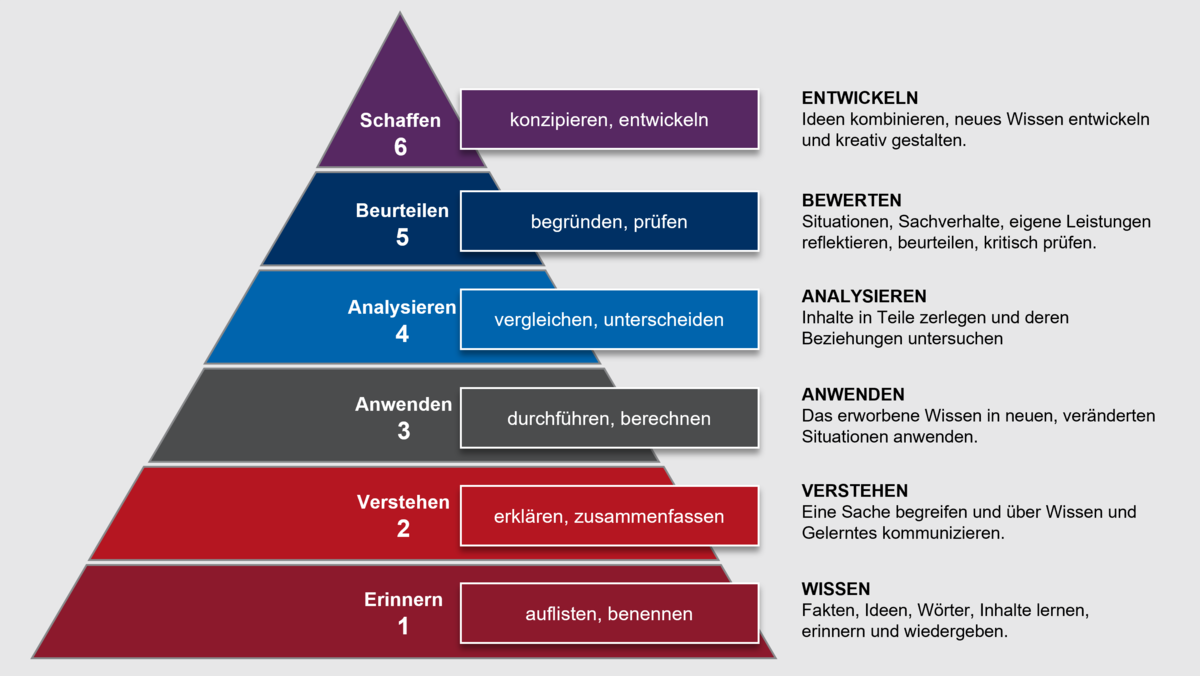
Methods and media
After analysing the framework conditions, contents and objectives, you can now make decisions regarding teaching methods and media.
Relevant guiding questions for planning are e.g.:
How do I want to prepare my content in terms of methodology? (expository, explorative, problem-oriented, playful or cooperative, and including case studies)
Do I want to resort to expository teaching methods, thus to the definition of a main learning pathway?
Are open, exploratory learning environments an option? (e.g. a Moodle course with adaptive learning pathways, with in-depth insights and various branches for exploration).
Are problem-oriented methods, i.e. learning with case studies, simulations, game worlds) appropriate?
Are playful methods suitable for my course?
Do I want to offer cooperative learning in social exchange and joint constructive activities?
... and which contents could this method be used for?
How do I want to present my content? (as a lecture, in a video, as text for reading, as a podcast to listen to, as a Moodle course, through various Moodle activities, on digital noticeboards, as a quiz or test in a polling tool (ARS), ...).
How do I want to activate my learners?
How do I want to ensure learning transfer? (via forum, noticeboard, task, ...)
Which tasks are to be worked on and solved during my course?
Can the chosen medium or assignment really achieve the learning objective?
Structure and organisation
The resulting organisation of learning includes all decisions on temporal, spatial and social organisation, including media-based elements, in-person elements, synchronous and asynchronous communication. Decide how your course is organised (e.g. in blended learning format and with which internal structure), whether and how supervision will take place (supervision concept) and which communicative and constructive/cooperative activities for activation, e.g. by means of group work, you are aiming for.
Relevant planning questions are e.g.:
How do I want to structure my course? (hierarchical, expository as a fixed learning pathway vs. open learning pathway for explorative learning with several in-depth possibilities).
What should the internal structure of my course look like? (List of learning units incl. possible branches)
How would I like to map out and design my course digitally in Moodle? (design, layout, structure)
How do I want to combine in-person and media-based elements?
Blended learning concept
Which learning objectives can be better achieved in the self-learning phase and which can be better achieved in the in-person class?
Which teaching and learning activities are necessary in the self-learning phase and in in-person teaching for achieving these learning objectives? (e.g. How to teach? How to activate?)
Will the self-learning phase and the in-person class be in line with one another?
Supervision & communication concept
What type and intensity of communication am I aiming for? (synchronous / asynchronous communication / in-person communication, informal exchange or joint work as collaboration)
Which forms of supervision and guidance do I want to offer? (no guidance, 1:1, tandem, small groups, community)
Will I offer (online) consultation hours and/or host a Moodle forum for questions?
Feedback and assessment
Recording learning outcomes: Were your learning objectives achieved? Please look back at the learning objectives you initially formulated and reflect: How would you like to check whether these learning objectives have been achieved?
Relevant guiding questions for planning are e.g.:
What does a suitable exercise or examination task look like in order to make the amount of the learning objective that has been achieved visible?
Am I bound by specifications when conducting the assessment? (oral: synchronous on site vs. asynchronous via video, written: synchronous paper-based or PC-based at the university’s e-Examination Centre vs. asynchronous as written assignment, portfolio, ...)
Is formative testing interesting for me? (ungraded, accompanying self-tests during the semester)
Which feedback options do I want to offer for exercises and exams?
Based on Kerres (2012)
Step 2: Look at digitised teaching scenarios and select own preferences
Would you like to gain an overview of digitised teaching scenarios and select suitable approaches for your own course? A helpful, theoretically guided introduction to the planning of digital teaching concepts is provided by the consolidation of various digital learning elements and learning formats produced by Wannemacher et al (2016), which names eight digitised learning scenarios.
They are divided into three mutually exclusive learning scenarios (enriched, integrated, online) and five learning scenarios that can be combined with each other (interactive, open, playful, personalised, self-organised). Based on this, you can start thinking about which form of digitisation you would like to use for your course.
Digitised Learning Scenarios
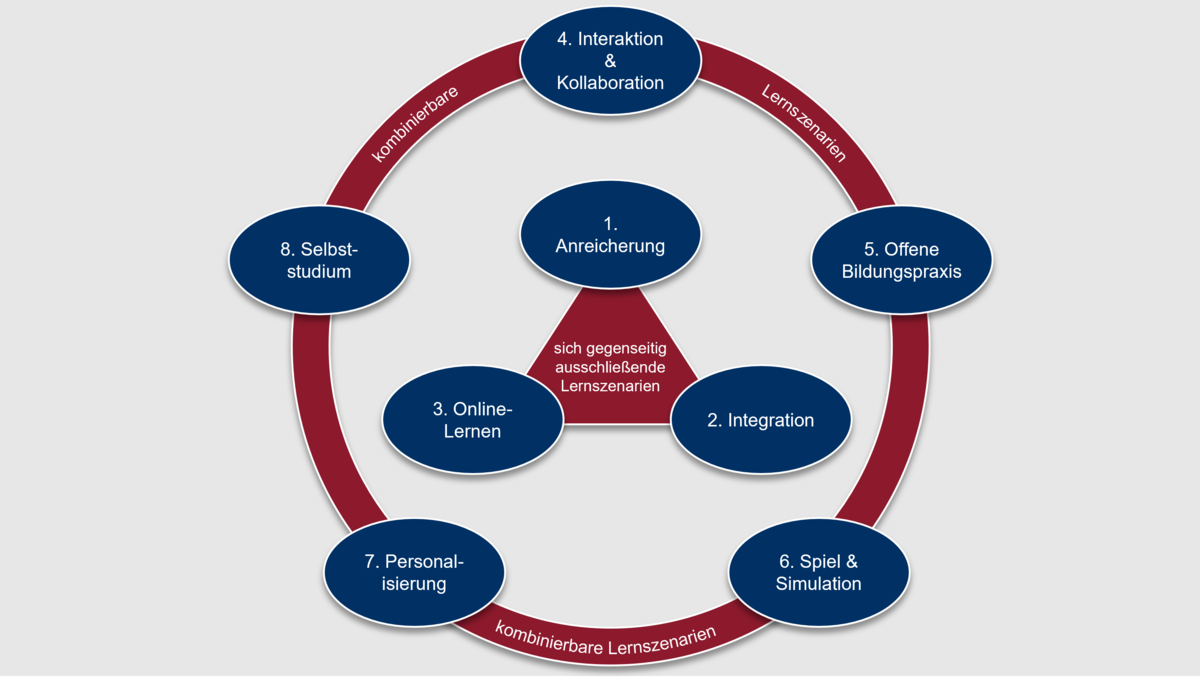
Digital Enrichment, Digital Integration or Online Learning
Excerpts from Wannemacher et al (2016): pp. 62
The learning scenario ‘Enrichment’ is an entry-level scenario for the field of digitised forms of learning in which digital media are added to regular courses such as lectures, seminars or exercises. Classic examples of the enrichment concept are the digital provision of seminar reading materials, lecture notes, lecture recordings, learning programmes or self-assessment tasks, which can be used to accompany classroom lectures.
The learning scenario "Integration" combines the forms of the Blended Learning Concept, in which attendance components and digital components are coordinated and interlinked, and synchronous and asynchronous learning phases complement each other. Individual components of regular in-person events are replaced by digitised learning elements and formats. The mix of in-person and online learning situations in blended learning approaches can vary immensely. At the same time, the learning scenario "integration" is closely linked to the didactic concept of the inverted classroom (also called flipped classroom). In this concept, which stands for a reversal of traditional frontal teaching, the teaching and learning of teaching content takes place online prior to a classroom event (e.g. through videos, e-books, or through the exchange of course participants in online communities). The attendance phases then serve to apply and consolidate what has been learned.
The scenario "Online learning" includes learning offers that are used almost entirely online and include hardly any or no compulsory in-person attendance phases, including completely digital courses such as Online seminars, e-lectures, full online degree courses or MOOCs.
| Enrichment concept | Integration concept | Virtualisation concept (online learning) |
|---|---|---|
| - Supplementary use of a learning platform (Moodle) | - E-learning is a supporting pillar of the class | - No more attendance components, purely virtual teaching |
| - In-person seminars continue to be the main pillar of the course | - Presence and e-learning alternate and are related to each other (blended learning) | - Tutorial support for the web-based events |
| - Examples: Online provision of lecture materials, e-assessments for checking attainment of learning objectives, digital consultation hours for exam preparation | - Examples: Flipped classroom, virtual learning phases between in-person classes with self-learning tasks and/or group work | - Examples: Online seminars that can use different methods and digital media, MOOCs |
Interaction & Collaboration, Open Educational Practice, Game & Simulation, Personalisation and Self-Study
Excerpts from Wannemacher et al (2016): pp. 73
The learning scenario "Interaction and collaboration" includes all kinds of use of social media and networks and interactive applications for working jointly on documents, wikis, blogs, podcasts, chat software, instant messagers etc.All applications from the area of collaborative learning, in which several students interact simultaneously using collaboration software and the actions of the participants form the focus of the learning process (e.g. working on case studies together, solving a problem within the group), up to peer learning, in which students support each other with study problems or in the learning process, can also be assigned to this scenario.
The scenario "Open educational practice” is linked to the principles of the open source movement. The focus is on the use of high-quality free learning materials, i.e. learning media that are in the public domain or can be adapted on the basis of free licences (e.g. learning materials from open educational resources), as well as free access to study offers and learning materials (open courses and some MOOCs).
The scenario "Game and simulation" includes the different variants of game-based learning, i.e. learning based on games, in which a synthesis is sought between the teaching of knowledge, skills and abilities and playing (e.g. digitised learning games such as interactive online planning games, quizzes, webquests, gesture-based games, action, adventure and role-playing games through to massively multiplayer online games), and gamification, in which game-typical elements are inserted into a non-game-based context. This learning scenario also includes simulation-based forms of learning, i.e. interactive visualisations to train specific knowledge or skills, as well as forms of "augmented reality", i.e. the visualisation of information about objects in the real environment on smartphones, tablets or similar, and "virtual reality", the complete immersion in a virtual environment using output devices such as data glasses and virtual reality headsets.
The "Personalisation" scenario includes learning formats that focus on personalisation and adaptation to individual learning needs. Adaptive learning plays a special role here, i.e. the use of adaptive learning environments that gear the selection of learning materials and tasks to the individual needs of learners. Adaptive learning environments either adapt learning content to individual needs using a specially configured system or enable learners to select and present learning material in an individualised and personalised way (individual learning pathways).
The learning scenario "Self-study" includes all forms of digitised support for self-study processes used in the context of in-person teaching. Numerous variants of mobile learning fall under this model, i.e. situational forms of learning that are used with the help of mobile devices such as smartphones, tablets and notebooks and corresponding learning applications. Diagnostic e-assessments, which help to identify student deficits in the run-up to a course and to compensate for them through additional offers, as well as formative e-assessments such as tests that promote learning by means of simulations, which serve to determine the learning progress during the course of a learning situation and to better control the students’ further learning process, are also part of this learning scenario. E-portfolios, which serve as a digital collection of learning process documentation and learning products to illustrate and evaluate the learning process, can also be assigned to this scenario, as they make student work visible and assessable and can thus support the learning process.
Based on Wannemacher et al (2016)
Step 3: Get to know digital education concepts in more detail and implement them
Would you like to be guided by best-practice digital education strategies? Here you will find successfully tested digital education concepts. However, they often require the preliminary considerations and planning steps listed in steps 1 and 2 in order to be successfully adapted.




